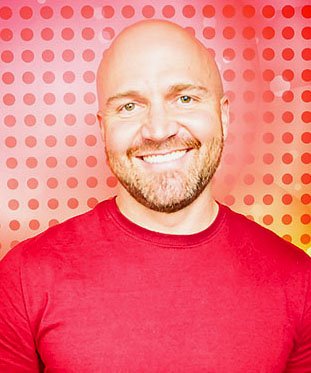
Design Star fans will delight in my upcoming series of interviews with HGTV faves for Williams-Sonoma’s Designer Marketplace, starting with this chat with Season 3 runner-up Matt Locke! As most of you know (since I blab it every chance I get), Matt’s become a close friend of mine over the years, and there was no one I’d rather kick off this new series than him. Matt’s been celebrated as both a designer and an accomplished artist, and is currently finishing up the job of his dreams.
Williams-Sonoma has been kind enough to allow me some irreverence in the posts I’ve contributed in the past, but as it is geared toward the trade, a certain level of professionalism must prevail in their blog content. Not so here! I saved a bit of dish for Fu For Thought…what follows are some bonus nuggets from our conversation:
Sometimes what a client wants and what they actually need are opposite things. Once a client feels married to a design direction, it can be hard to dissuade them…as Matt reveals in this anecdote:
I lost a job designing January Jones’ kitchen. We had a mutual contact and I was brought in to bid for a remodel. She wanted Carrera white marble countertops and these country blue cabinets. I worked with my sister, who’s my draftsman, and we came up with several spaceplans. I made a recommendation to her, please not to use Carrera marble, because no matter how well you seal it, it stains. If you spill red wine on it or olive oil, or get anything hot on it, you’ll see that for the rest of the lifespan of the countertop—it only looks good for the first couple of months. The feedback that I got through her manager was, “Why is this guy not doing what we asked? We just want him to draw up the floorplan that we asked for, with the finishes we already know we want.” So another designer came in who works with big-time celebrities, did a beautiful presentation with all of the things that she wanted and got the job. She got the white marble countertops she wanted. Sometimes the clients just want what they want.
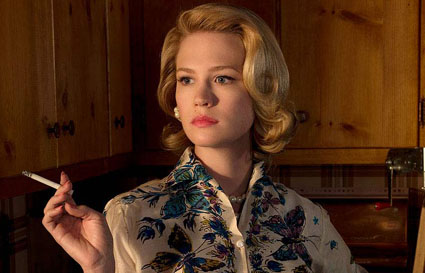
I said, Carerra. CA-RER-RA! (Photo courtesy of Snark Food)
We talked a little bit about Design Star.
What happened on Design Star for me was a little boot camp. I liked being on that show a lot, but especially because I learned from my fellow designers, especially Stephanie Cook and Trish Beaudet—how to add soft touches to a room. As a builder and an architect and engineer at heart, those things were not my priority (before DS). I was much more interested in making the space clean, functional and useful. They taught me how to make it pretty and appealing on top of that. I have incorporated those principles in my design across the board, and I’m really thankful for that experience because I notice those things now.
Matt has a very modern design style and I wondered how that played in his home state of Colorado.
I presented work for a juried show in Colorado called the Cherry Creek Arts Festival, and it’s one of the best-attended arts festivals in the entire country. They get between 300,000-400,000 people through there on July 4th weekend. Some artists make their living—or at least a big chunk of their annual revenue—at that one show. I was one one of eight selected for their inaugural Emerging Artists program and I worked like a dog to create a series of functional sculptures. I exhibited them at the festival and nothing sold. It was after that that I decided to move. There are modern things in Denver, of course, but something about what I made didn’t click. My house in Palmer Lake, CO was very controversial and I heard lots of people in my little town talk about how much they hated my house. The exterior was a very earthy adobe and the interior featured an updated Deco design. I like that contrast between having a very finished interior and an unassuming exterior. I remember some neighbors came over, looked around and sort of scowled and said, “This looks like our cousin’s place in San Francisco. He’s an architect and makes really modern things like this and when he came into our house, he told us it was schlocky.” I had been in their house and it was schlocky! When I moved out to LA and people saw my Palmer Lake house and my functional sculptures, they all liked it. I realized how important it was to find the market that fits your style.
Every artist is inspired by different things. For Matt, minutiae’s the thing.
What’s funny is the reaction I get when I show (my New York Subway piece) to other creative people. When they see what I did to make this map and the tedious level of detail it took to trace over all of New York City’s streets in Adobe Illustrator, they glaze over and say things like, “That looks like torture. I would never want to have to do that.” For me, it was a sheer delight. There was a whole month where I sat in front of my computer and did nothing but that. I had my routine… I put on old movies that I’ve watched a million times and I would click-click-click. I got a huge knot in my back and all sorts of symptoms of repetitive stress disorder in my arm but I didn’t care. I did nothing but click and go to the gym—it was paradise! As I sit and click and manipulate things on my monitor, I am in seventh heaven. It makes me realize it’s what I’m here for. That’s what I’m supposed to do, because it’s work, obviously, but it’s work that is deeply satisfying to me.
I’ve always liked to hang maps on my wall, or look at maps and look at the atlas, I love woodworking, I love modern architecture, and all those things have come together in this project. There are so many ways to express the same idea. There are so many cities and so many expressions of maps and architecture and this intersection of materials and the subway is such a fantastic way to do that. It’s really been the best job I’ve ever had.
Fans of Matt can also see more examples of his work at mattlocke.com, and I highly encourage you to follow him on Facebook. The creative exercises he posts there are really amazing.
*The following content originally appeared on Williams-Sonoma Designer Marketplace.*
From Jeopardy! to Design Star, an Interview with Matt Locke
Nothing in six seasons of HGTV’s Design Star has ever topped Matt Locke’s innovative five-person bedroom design for the reality show’s home base during season three. He’s the kind of designer who can take mundane elements like kitchen soffits and turn them into something worth coveting. On top of his design talent, Matt’s easygoing and drama-free attitude made him a favorite among HGTV viewers. Ever since he read the Design Star recaps I’d written for my blog Fu For Thought, Matt and I have been fast friends. It was fun to have an official reason to grill him about his design career.
What types of services do you provide at Matt Locke Design?
I have a full service design company, so that includes interior design, construction, permitting, and all of the little bits of interior design: paint selection, furniture, anything to do with general construction like plumbing and electrical. My firm can handle all of those things.
What is the quintessential Matt Locke look?
I like clean, simple shapes. I love modern design aesthetic, but I like for it to be warm, inviting and livable. I do that by using the principles of modern design, but with warm finishes like wood and warm colors.
What inspired you to try out for Design Star?
When I came to Los Angeles in 2005, I wanted to be a full-time designer, I wanted to get on Jeopardy! and I wanted to be on a design television show. I looked around and realized that Design Star was the best way to get my foot in the door, and I just applied.
I forgot about your smarty-pants Jeopardy! appearance!
Oh, it wasn’t so smarty-pants. Thank God they don’t keep those videos on YouTube! I went into Final Jeopardy with $600 and the returning champ had over $19,000. I missed the final question and ended the night with zero.
What are some of the challenges of designing for TV vs reality?
The budgets are miniscule, the timing is too short to do something actually livable and professional, and colors and shapes look different on camera. So you have a knack for it or you have to learn it. I would say someone like David Bromstad (host of HGTV’s ColorSplash and winner of the first season of Design Star) knew from the get-go how to make something look great on camera. I had to learn as I went. There’s a way to fill the space, so as the camera pans the room, it all looks finished and complete. That is different from a livable environment, where all of the pieces would actually be functional. I think for some designers, it’s a relief, because it’s more of a gesture. You don’t have to get every little thing right for it to last three years of use by a family. So if you’re a quick thinker and just want to get your idea out, it’s a great way to do that.
How did appearing on Design Star affect your business?
Appearing on Design Star got me a lot more media work. I was able to do an endorsement for S.E. Johnson, I did public appearances at home shows, I filmed several pilots, I appeared on HGTV’s Showdown and very soon, I’ll be co-hosting an online makeover show on SheKnows.com called HomeStretch. Appearing on Design Star doesn’t translate to more design work, because people view a television designer as being out of their reach, unapproachable, or too busy. It definitely occurs to people who make TV shows and books and home shows to contact me for more work, but I don’t think any of us designers got any more design work from being on the show.
A designer typically only receives feedback or criticism from a client, but when you design for TV, the entire viewing public is critiquing your work. How did that affect you?
I read everything. I felt like it was part of the boot camp experience of being on the show. I took a lot of the critiques to heart and realized my work could be improved. I didn’t really take it personally or get too upset. The only thing that got under my skin was when I did the hometown challenge and (Design Star judge) Martha McCully was horrified that I bought these big, dark brown leather chairs for my parents’ game room. I remember her saying many times, “How could he put those big, heavy chairs in there?” But those ended up being my parents’ very favorite part of that room. Even thought they’ve retired and moved to a different place, they took those chairs with them. Sometimes you have to take those critiques with a grain of salt and know you did the right thing for the client. But it was rare to read something that was completely off the mark. Usually, you know what’s going right and wrong in your room. There were mean comments about all of us on the show that didn’t have anything to do with design—that’s just part of being on TV. One of the things I’ll always remember was on those HGTV message boards, I was called “Stupid Hat Matt.”
Before you moved to LA, you lived in the Denver area. How is that market different from the LA market?
In Denver, there’s a mix. They love antler lodge style, they love faux Tuscan, a nice, safe, suburban home style. Nothing too sparse or edgy. There are lofts downtown and those tend to be styled a bit more modern, but if you come to LA you’ll see house after house of people who love Eames chairs and Barcelona chairs and it gets even a little bit monotonous. Here, people rely so much upon the modern classics. In Colorado, I don’t honestly think people like to spend as much money on those kinds of things.
What did you do to help your business ride out the shaky economy?
I had to focus a lot on providing really exceptional customer service and making sure that the few clients I did have during the recession were happy. In my case, that meant responding to text messages and emails at midnight or on the weekends, and I was happy to do it. It meant going the extra distance because there just wasn’t any work.
One thing I noticed during the recession was that here in LA, people did not want to risk their investment on a brand new design. It became a very safe environment where people would spend money on reproductions of the classics, but they would not buy interesting, fresh, new stuff. You can introduce a really fresh take on a lamp, but there’s no guarantee that people are going to respond to it during that type of economy. I have designed my own furniture and lights and I’ve also curated a collection of designers whose work I thought was important and new and it was just surprising to see how safe everybody wanted to play it. One of my other clients, who runs this really fantastic shop selling true antiques, has done quite well during this economy. The stuff that he sells has a name and a pedigree. People really like that. I think it comes down to almost that cocktail party scenario. When your friends come over and say, “That’s a pretty table,” you can say, “That’s a such-and-such!” Then there’s that Oh! moment. You don’t have that with a new designer’s work. It’s a curious thing.
Did you notice an increase in referrals as a result of that elevated level of service?
What I found out is that my clients definitely referred me out and had really nice things to say, but it was just a matter of people not hiring anybody. A client told me, “I talk about you all the time,” which was great to hear, but it made me realize that people just did not want to spend money at that time.
How do you handle difficult clients?
I look at this in a different way than some designers. My life was a safe, corporate benefits kind of world, and I left that to pursue my dream. Now that I’m here and it worked out, I’m very thankful and I’m much more willing to tolerate crazy behavior or unusual requests. I know these people pay my bills. Doing these jobs is how I live. Which would I prefer? A little drama with a client, or being stuck in a cubicle doing a job that doesn’t satisfy me? Every time I get frustrated, I just remind myself that I would much rather be doing this. I also go to the gym. All of the frustration I have from whatever it is—family, job, money—I just take it out on the weights!
What is your greatest creative achievement to date?
I’m currently working on a project that really appeals to me in every possible way. A family is building their ultimate dream house in La Jolla and they’ve commissioned me to create an artistic wall sculpture interpretation of New York City’s subway map in wood. They love New York and vacation there many times a year. They have a real love for the city and for the subway system and thought it would be cool to commission an original piece of art to represent that experience. The piece I’m doing will be going in their staircase and is two stories tall! The islands are machine-cut out of walnut plywood, based on a file I created in which I traced over every street and the boroughs by hand. I’m doing trials with the subway lines, to create them out of acrylic. The streets are channels that are cut into the wood that will be inlaid with aluminum or bronze. For the water, I found a textured metal and printed a collage of photographs I took in New York on it. I love design, I love my clients, I love the work that I do, but this project is different because it really is art. It’s art expressed in a way that makes me extremely happy. It’s very technical and has elements of woodworking, elements of modern architecture, there’s engineering, there’s lighting. It’s a microcosm of all of the design work that I do, but in an environment in which I have far more control. As I’m doing it, it occurs to me how much I need to be doing this all the time, using other cities, maps and architecture for inspiration.
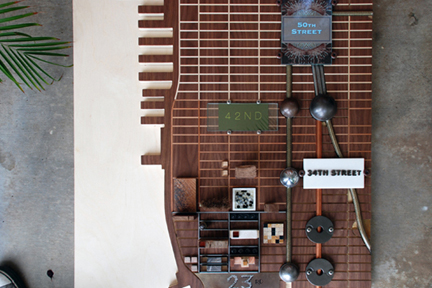
Matt’s prototype for the mixed-media wall sculpture he’s currently working on, inspired by the New York subway system.
Do your clients know it’s the best job you’ve ever had?
I have told them many times that they have made my dreams come true and how thankful I am. It’s such a crazy thing, the chronology of events. I will say that Design Star played into this very directly. After I appeared on the show, I was invited to exhibit at Dwell Magazine’s convention downtown and that’s how I met these clients.
What is your guilty pleasure in terms of home décor?
My favorite thing in the world is iridescence. That peacock feather quality? I fall for it every time. If it looks like auto paint or a peacock feather, I like it—it doesn’t matter what it is. You could spray paint a ceramic monkey head an iridescent color and I will want it!
Now I know what you’re getting for your birthday!
Yes!
Find out more about Matt by visiting his website at mattlocke.com. Stay tuned for more interviews with your favorite celebrity designers, including David Bromstad, Kim Myles, and Antonio Ballatore!
(Photos courtesy of Matt Locke, unless otherwise noted.)

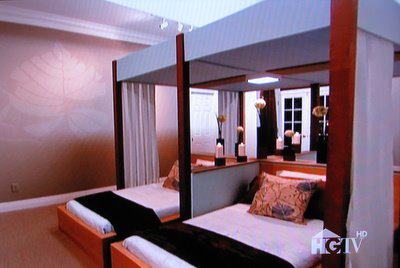
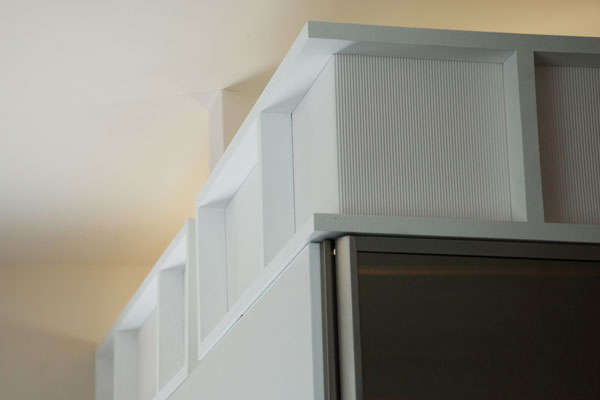

Someday, I’m gonna meet this fella’. (:
I’m glad you’re using the “leftovers” (which are actually the JUICE) from your interviews here.
It’s also funny that other creatives have that reaction to his Subway piece – that’s the reaction I had. That looks like it has to be miserable. Hahahaha. Shoot- he really should take that and run. Clearly there aren’t many people out there with the patience…or the love to DO things like that. *Do Austin next Matt!!!*